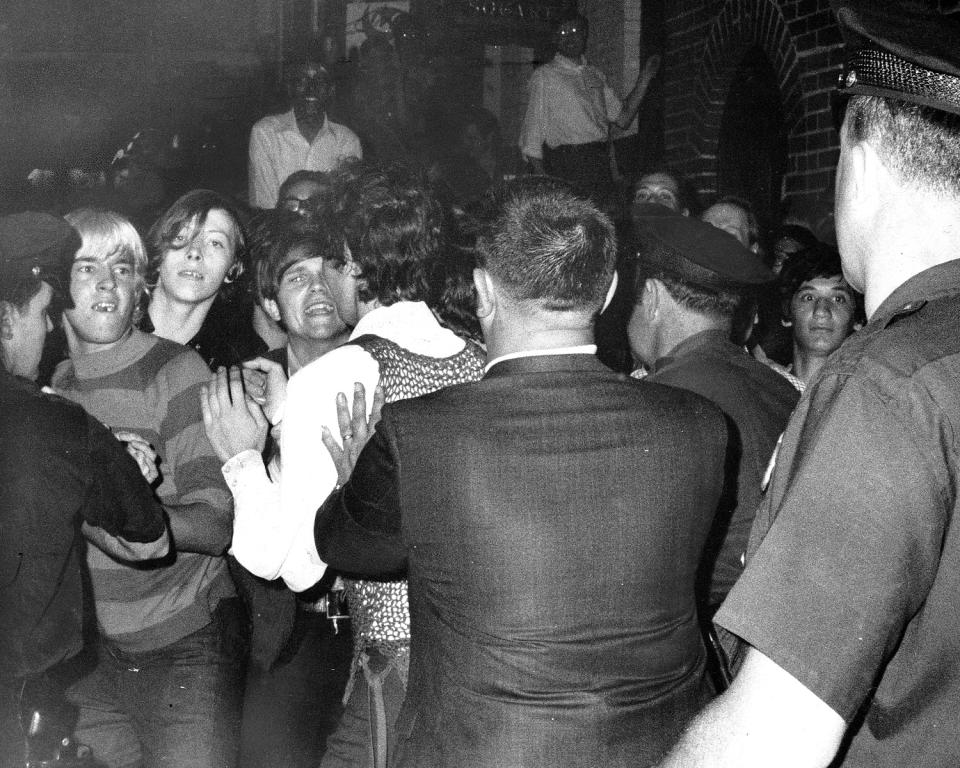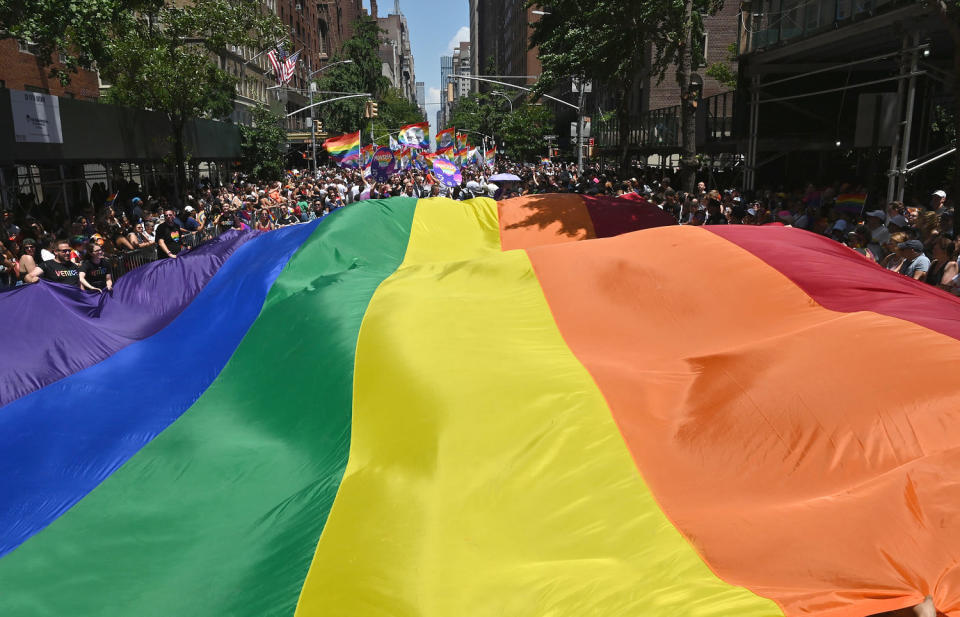It's officially Pride Month. What to know about its history and why its celebrated
Pride Month is official here, bringing events, marches, parades, festivities and remembrances dedicated to the LGBTQ community to U.S. cities and countries throughout the world.
The annual commemoration recognizes those who identify as LGBTQ community members, as well as their supporters and allies.
Pride Month events typically culminate on June 28, the anniversary of the 1969 Stonewall Uprising in New York City.
Though celebrations often mark the occasion, Pride is also a call for greater unity, visibility and equality for the LGBTQ community, as well as being a time to reflect on the history and milestones of the past 50 years.
What is the meaning of Pride Month? According to GLAAD, the annual recognition provides “an opportunity for the community to come together, take stock and recognize the advances and setbacks made in the past year. It is also a chance for the community to come together and celebrate in a festive, affirming atmosphere.”
To learn more about the month-long recognition, see below for facts on the meaning of Pride Month, the history behind why it's celebrated, the meaning of the rainbow flag, a list of notable 2024 events, as well as important resources and other helpful information.
Here's what you need to know.
What is Pride Month?
From June 1 to June 30, Pride Month spotlights LGBTQ voices and celebrates LGBTQ culture, achievements and activism through a series of organized activities, including film festivals, art exhibits, marches, concerts and other programs throughout the month.
Through these efforts, the LGBTQ community and its allies aim to spotlight LGBTQ voices, increase awareness and knowledge on issues of inequality, as well as commemorate the lives lost to violence and the AIDS crisis.
Why is Pride Month in June?
Pride Month is observed in June to honor the anniversary of the Stonewall Uprising, a touchstone event in LGBTQ history.
In the late 1960s, being openly gay was largely prohibited in most places. New York, in particular, had a rule that the simple presence of someone gay or genderqueer counted as disorderly conduct, effectively outlawing gay bars.
On June 28, 1969, patrons of the Stonewall Inn, a popular bar with a diverse LGBTQ clientele, stood their ground after police raided the establishment. The resulting clash led to days of riots and protests, known as the Stonewall Uprising.
One year later, on the anniversary of the Stonewall Uprising, thousands of people flooded the streets of Manhattan in the Christopher Street Gay Liberation Day March, regarded as the first gay pride event ever.

How did Pride Month begin?
Before Pride became a month-long commemoration, it was initially recognized as Gay Pride Day, observed annually on the last Sunday in June.
However, as awareness increased, more activities and events were planned spanning the entire month and, eventually, Gay Pride Day evolved into the month-long recognition we now observe as Pride Month.
The designation became official in 1999 when President Bill Clinton officially declared June as Gay and Lesbian Pride Month, setting aside the month as a time to recognize the LGBTQ community’s achievements and support the community.
What is the symbol of Pride?

The rainbow flag is universally recognized as the symbol for LGBTQ pride. It was created by renowned San Francisco activist Gilbert Baker.
According to Baker, “the rainbow of humanity" is intended to symbolize all genders and races.
Each of the six colors of the rainbow flag represent a different aspect of the LGBTQ movement: life, healing, sunlight, nature, serenity and spirit.
In 2017, Philadelphia added a black and brown stripe to their flag to symbolically represent LGBTQ people of color who have often felt marginalized from their own community.
Today, many organizations have adopted the flag, with some adding the colors of the transgender pride flag, which are baby blue and light pink.
You'll find a full list of LGBTQ flags along with their meanings right here.
How can I participate in Pride Month 2024?
Along with reading LGBTQ-inspired books or posting a meaningful Pride Month quote on Instagram, you can join in any of the nationwide celebrations held throughout the month of June.
One of the largest Pride marches occurs in New York City, the birthplace of modern gay rights movement. The NYC Pride parade will take place on Sunday, June 30, this year.
The annual event is one of the country's biggest Pride events, drawing nearly 2 million attendees.
Here’s a list of some U.S. cities hosting Pride Month events this year:
Baltimore: June 10 — 16, 2024
Chicago: Pride Fest, June 22 — 23, 2024; Pride Parade, June 22
Denver: June 22 — 23, 2024
Detroit: June 8 — 9, 2024
Key West: June 5 — 9, 2024
Los Angeles: June 8 -9, 2024
Nashville: June 22 — 23, 2024
New Orleans: June 7 — 9, 2024
New York: June 30, 2024
Philadelphia: June 2, 2024
Portland: June 20 — 21, 2024
Provincetown, RI: May 31 — June 2, 2024
San Francisco: June 29 — 30, 2024
Seattle: June 30, 2024
Other important dates during Pride Month
June 5: HIV Long-Term Survivors Day, honors and increases visibility around HIV survivor issues and needs
June 12: Pulse Remembrance Day, a remembrance of the 2016 Pulse nightclub shooting victims
June 19: Juneteenth, a commemoration of African American culture and the emancipation of African American slaves
June 27: National HIV Testing Day, encourages individuals to be tested for HIV
June 28: Stonewall Riots Anniversary, commemorates the 1969 Stonewall Uprising
June 30: Queer Youth of Faith Day, to celebrate and empower LGBTQ youth of different faiths
LGBTQ Pride Month resources
To learn more about Pride Month or find additional ways to get involved, check out the following resources:
GLAAD, a non-government agency founded to promote LGBTQ acceptance along with identifying and preventing discrimination against lesbian, gay, bisexual, transgender and queer individuals.
GLSEN, a network of students, families and education advocates working to facilitate LGBTQ safety and support in schools.
The Equality Federation is a LGBTQ advocacy group working to help advance the rights of LGBTQ people.
The National LGBTQ Task Force, an advocacy group dedicated to advancing freedom, justice and equality for LGBTQ people.
The Library of Congress, for history on lesbian, gay, bisexual, transgender and queer Pride Month.
The Anti-Defamation League, an anti-hate organization dedicated to fighting bias, extremism, discrimination or hate.
The American Civil Liberties Union, works to preserve and defend the rights and liberties of U.S. citizens.
This article was originally published on TODAY.com